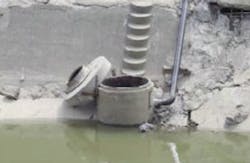Restraining the River
The Metropolitan Sewer District (MSD) of Greater Cincinnati had two combined sewer overflow (CSO) manholes at the Mill Creek Interceptor that became surcharged and overflowed to the river. It tried a typical fix by bolting down the manhole lids to prevent the discharge, but the lids would be broken off due to surge pressures in the CSO from the throttling of flow into the plant.
When the river’s water level rose, the broken-off lids allowed river water into the CSO and ultimately into the treatment plant; the MSD estimated the inflow at 10 to 50 mgd. A detention facility was not feasible, due to the size required to contain 16.8 million gal of flow.
Hydro Controls, the local Red Valve Co. and Tideflex Technologies representative, was contacted to help find a solution. After consulting with Tideflex engineers, two 48-in. Tideflex Waterflex WF-3 valves were custom-engineered with a four-quadrant opening disc so they would not clog. The valves were designed with a preload of 8 in. before the valves started to overflow when the CSO surcharged. The Waterflex valves provide very low head-loss characteristics, with high backpressure ratings.
The custom Waterflex check valves will provide a long service life because the reinforced elastomer disc is the only moving part and requires no maintenance.
